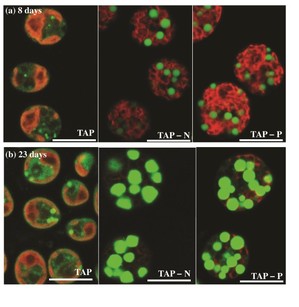Research Highlights
Lipid accumulation enhancement achieved using nutrition starvation-inducible promoter in algae
Summary
Masako Iwai, CREST Researcher and member at the Center for Biological Resources and Informatics at the Tokyo Institute of Technology, and Professor Hiroyuki Ohta, of the Earth-Life Science Institute and Center for Biological Resources and Informatics at the Tokyo Institute of Technology, have succeeded in enhancement of the lipid accumulation function in nutrient-starved algae maintaining the cell growth through photosynthesis. This was realized by a gene transformation using a phosphorus starvation-inducible promoter. (1). This result represents a big advance for the production of bioenergy at the industrial level using algae.
Using the model algae Chlamydomonas (2), it was discovered that lipid accumulation in phosphorus-starved cells differed from nitrogen starved cells, which has been conventionally known. The accumulation of TAGs (3) in phosphorus-starved cells was possible while also maintaining thylakoid membranes (4), where photosynthesis takes place. Focusing on genes, which expressions are increased under phosphorus starvation, a transformation system was constructed that could enhance the accumulation of lipids under phosphorus starvation conditions. It is expected that this system will be used in the future to not only enhance lipid accumulation, but also manipulate the kinds of fatty acids included in lipids.
The research was a joint effort with Mie Shimojima, assistant professor at the Tokyo Institute of Technology's Center for Biological Resources and Informatics, and Keiko Ikeda, technical staff at the Tokyo Institute of Technology's Biomaterial Analysis Center. The results of the research appeared in the English scientific journal "Plant Biotechnology Journal" volume 12 issue 6 on August 2014. The electronic version of the same was published on 9 June.
Professor Ohta received a Core Research for Evolutional Science and Technology (CREST) "Creation of fundamental technology to create bioenergy through the clarification and control of the functions of algae and water microbes" selection for this research, which was carried out as part of "strategic construction of algal lipid production system utilizing plant vegetative organs as a model."
 Culture at 8 days (a - Top), and 23 days (b - bottom). The green indicates oil droplets where TAGs have accumulated, while the red indicates thylakoid membranes. TAG accumulation can be observed under two nutrient stress conditions. Thylakoid membranes can be observed even at 23 days under phosphorus starvation conditions (Right).
Culture at 8 days (a - Top), and 23 days (b - bottom). The green indicates oil droplets where TAGs have accumulated, while the red indicates thylakoid membranes. TAG accumulation can be observed under two nutrient stress conditions. Thylakoid membranes can be observed even at 23 days under phosphorus starvation conditions (Right).
Explanation of Technical Terms
| 1.Phosphorus starvation-inducible promoter: | When algae and plants are starved of phosphorus, a variety of responses in order to adapt to the phosphorus starvation occur, such as membrane lipid remodeling in which they start to mine the missing phosphorus from the phospholipids that make up biological membranes, and synthesize glycolipids in place of phospholipids. In the genes whose expression is induced when this happens there exist control areas called promoters that induce expression of genes in response to phosphorus starvation. |
| 2.Chlamydomonas: | A kind of single-cell algae belonging to the Chlorophyceae Chlamydomonas order. Its genome sequencing has been completed, and it is used as a model algae. |
| 3.TAGs: | Triacylglycerols. Neutral fats that are esters synthesized from one molecule of glycerol and three molecules of fatty acids. |
| 4.Thylakoid membranes: | Highly developed membrane structures that exist in the interior of chloroplasts. They include photosynthesis electron transmission devices and ATP synthases, and are important membrane structures governing the conversion of light energy into chemical energy in photosynthesis. |
Reference
|
Authors:
|
Masako Iwai, Keiko Ikeda, Mie Shimojima and Hiroyuki Ohta
|
|
Title of original paper:
|
Enhancement of extraplastidic oil synthesis in Chlamydomonas reinhardtii using a type-2 diacylglycerol acyltransferase with a phosphorus starvation-inducible promoter
|
|
Journal:
|
Plant Biotechnology Journal
|
|
DOI:
|
10.1111/pbi.12210
|
Contact
Professor Hiroyuki Ohta
Center for Biological Resources and Informatics /
Earth-Life Science Institute (ELSI), Tokyo Institute of Technology
Email: ohta.h.ab@m.titech.ac.jp
Yu Yonehara
Earth-Life Science Institute (ELSI), Tokyo Institute of Technology
2-12-1, Ookayama, Meguro-ku, Tokyo 152-8550, Japan
E-mail: pr@elsi.jp
URL: http://old.elsi.jp/en/
Tel: +81-3-5734-3163 Fax: +81-3-5734-3416












